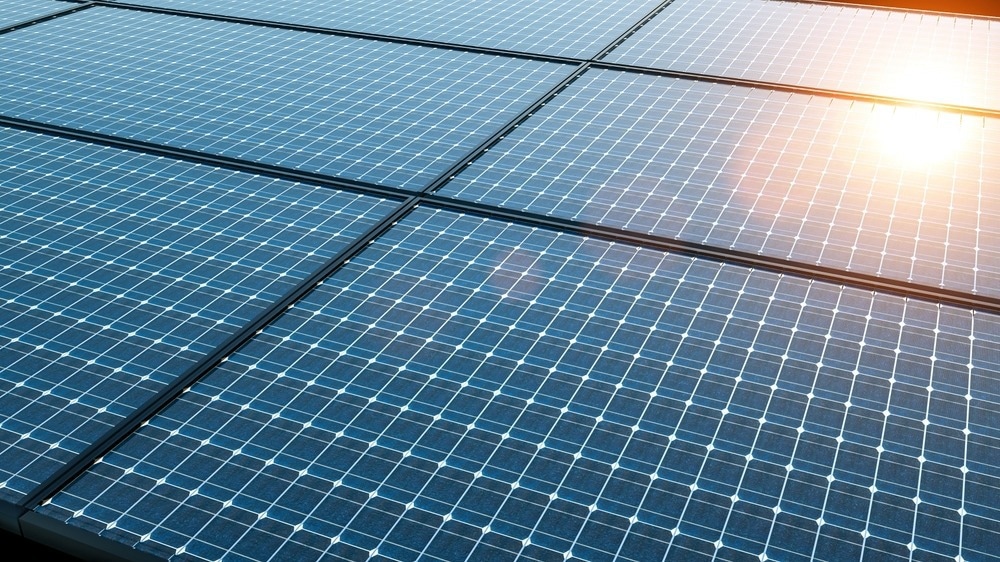A team of chemists from Kaunas University of Technology (KTU) in Lithuania, the creators of several revolutionary innovations in the solar energy field, suggested yet another solution to boost the performance and stability of perovskite solar elements.

Image Credit: Audio und werbung/Shutterstock.com
The KTU chemists synthesized a new category of carbazole-based cross-linkable materials, which are resistant to several environmental effects, including robust solvents used to manufacture solar cells.
When used as hole transporting layers, the new materials created at KTU labs helped realize 16.9% efficiency of the inverted-architecture perovskite cells at the very first trial. Upon further improvement, higher efficiency is expected.
New Materials Thermally Polymerized to Provide Resistance
Organic-inorganic hybrid perovskite solar cells have been gaining global attention as a competitive substitute for traditional silicon-based solar technologies. They are more economical, more versatile, and possess higher power conversion efficiency.
Globally, researchers are attempting to solve challenges associated with enhancing the stability and other features of the perovskite solar elements. These layered, new generation solar cells can contain two architectonic structures – regular (n-i-p) and inverted (p-i-n) structures. In the inverted one, the hole transporting materials are placed under the perovskite absorber layer.
Although p-i-n cells have numerous advantages when compared to the perovskite solar cells of regular architecture, they have serious shortcomings. For instance, the hole transporting compounds should be able to withstand the strong polar solvents used to form light-absorbing perovskite layer, which is placed above.
Professor Vytautas Getautis, Chief Researcher, Faculty of Chemical Technology, KTU
In p-i-n architectures, polymers are frequently applied as hole transporting materials to address this issue. However, because of solubility problems, a polymer layer is hard to form; furthermore, it is hard to regulate the recurrence of reactions and manufacture the same structure.
Targeting to resolve this problem, KTU scientists created a hole transporting layer of carbazole-based molecules, which then was thermally polymerized in situ to attain the cross-linking effect.
The cross-linked polymer has a three-dimensional structure. It is very resistant to various effects, including the strong solvents used while forming a light-absorbing perovskite layer. We used several groups of molecules and developed materials, which, while used as a hole transporting layer, can improve the efficiency of an inverted perovskite solar cell to almost 17 percent.
Šarūnė Daškevičiūtė-Gegužienė, PhD Student, Kaunas University of Technology
Šarūnė Daškevičiūtė-Gegužienė synthesized these compounds.
The above-illustrated invention was showcased as a cover article in Chemical Communications, published by the Royal Society of Chemistry, UK.
Authoring Record-Breaking Tandem Solar Cell
The research team guided by Prof Getautis has created several pioneering inventions aimed at enhancing solar cell efficiency. Synthesized compounds are one of them, which self-assemble into a molecule-thin layer that serves as a hole transporting material.
The silicone-perovskite tandem solar cells made using the new materials attained an efficiency of more than 29%. According to Prof Getautis, the latter tandem arrangement will soon become the commercially available substitute for silicone-based solar cells – more efficient and more economical.
Our field of research aims to improve the existing technologies for perovskite solar elements and in this field, we have achieved the best results with the self-assembling-monolayer technology. However, science is often developed in multiple directions, as we need to explore ways to use solar energy the best we can.
Professor Vytautas Getautis, Chief Researcher, Faculty of Chemical Technology, KTU
Although perovskite cells are an innovation compared to silicone-based solar technologies, numerous companies have already presented various products based on perovskite technology in the market.
Among them are flexible semi-transparent interior elements, wearable electronics to regulate the wildlife population, and numerous architectural solutions. Also, this is merely the beginning.
Prof Getautis states that among all renewables, solar energy possesses the largest potential and is the least utilized. However, owing to the new study, this field is expanding significantly. It is projected that by 2050, about half of the electricity utilized on earth will be generated from solar energy.
Solar energy is entirely green – it is pollution-free, and the installed solar farms don’t require much maintenance. Keeping in mind current events, and the energy crisis, more and more people are interested in installing solar power plants in their homes or owing a share of a solar farm. It is a future of energy.
Professor Vytautas Getautis, Chief Researcher, Faculty of Chemical Technology, KTU
Journal Reference:
Daškevičiūtė-Gegužienė, S., et al. (2022) Cross-linkable carbazole-based hole transporting materials for perovskite solar cells. Chemical Communications. doi.org/10.1039/D2CC02612K.